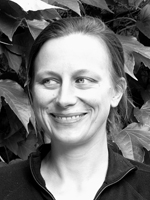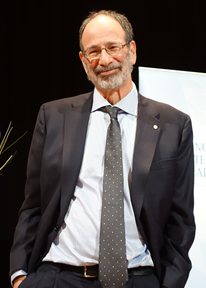This morning Spain's BBVA Foundation announced that Paul Milgrom has one the
Frontiers of Knowledge Award in
Economics, Finance and Management.
In the accompanying
video interview Paul cites Vickery and Wilson as his inspirations, and goes on to talk briefly about his current work on the FCC incentive auction, and how it has to be designed to satisfy the engineering constraints imposed by broadcasting, while being simple enough for bidders and addressing the revenue and efficiency concerns of the FCC.
Here is the prize
announcement:
***************
The BBVA Foundation Frontiers of Knowledge Award in the Economics, Finance and Management category goes in this fifth edition to U.S. mathematician Paul Milgrom “for his seminal contributions to an unusually wide range of fields of economics including auctions, market design, contracts and incentives, industrial economics, economics of organizations, finance, and game theory,” in the words of the prize jury. This breadth of vision encompasses a business focus that has led him to apply his theories in advisory work with governments and corporations.
Milgrom (Detroit, 1948), a professor of economics at Stanford University, was nominated for the award by Zvika Neeman, Head of The Eitan Berglas School of Economics at Tel Aviv University.
“His work on auction theory is probably his best known,” the citation continues. “He has explored issues of design, bidding and outcomes for auctions with different rules. He designed auctions for multiple complementary items, with an eye towards practical applications such as frequency spectrum auctions.”
Milgrom made the leap from games theory to the realities of the market in the mid 1990s. He was dong consultancy work for Pacific Bell in California to plan its participation in an auction called by the U.S. Federal Communications Commission, and was able to pinpoint errors in the auction design that produced a worse outcome for both organizers and bidders. He and Robert Wilson proposed an alternative method which the FCC agreed to try out. Their innovation, known as the simultaneous multiple round auction (SMR), replaced the traditional sealed envelope with an open bidding format, in which each company could observe what the rest were offering, supplemented by rules to prevent monopoly pricing. The auction – of electromagnetic spectrum for what was then the new generation of cell phones, pagers, and other wireless communication devices – raised the record sum of over seven billion dollars, and testified in the most practical way possible to the value of games theory in strategic decision-making.
SMR has since been used by governments the world over to auction not only airwaves but also natural gas, electrical power, etc.
Shortly after being informed of the Frontiers of Knowledge Award, Milgrom explained how this contribution came about: “I started out studying mathematics, but then moved to Stanford to study business and discovered the work of William Vickrey, who went on to win a Nobel prize for his work on auction theory. I was fascinated by this kind of mathematical approach to human behavior, and decided that was what I wanted to explore.”
Asked what makes the auction such an important mechanism, he replies: “Auctions determine how resources are shared out, they decide who gets what and at what price, at times even a lot of goods being offered simultaneously. They are important for the same reason that markets are important. Initially, no one can know what a given object is worth to each of its possible buyers, and we need a mechanism that gives us that information; a competition so buyers can show their interest through bidding and the resources go to the highest bidder, but also so resources end up in the hands of those who will put them to good use.”
Milgrom developed SMR to make this competitive process more efficient, as well as adaptable to non-price bidding mechanisms such as placing students into college courses, or reallocating airline slots in the event of bad weather at a crowded airport.
Auctionomics, the firm he created as an outlet for his research findings, has been engaged by regulators in the United States, United Kingdom, Canada, Australia, Germany and Mexico to advise on the design of auctions in strategic sectors.
This advisory role extends to both the organizers of auctions and those wishing to bid: “We help auction organizers to design them better. Normally the big challenge is to attract bidders. The auction has to be simple and easy to understand, but at the same time respect the complexities inherent to each situation, including technical and other constraints. If the client is a buyer, we help them understand the rules of the auction and think ahead to how much money they might need, what they can hope to get at what price, and what they can expect from competitors.” The technical guidance the firm provided to Comcast in a radio spectrum auction saved this client nearly $1.2 billion on its license purchases based on the prices paid by other large bidders.
Milgrom’s company is currently advising FCC on the incentive auction through which the Commission plans to reallocate part of the spectrum used for TV broadcasting to telephone operators, in an operation likely to be worth around 55 billion dollars.
Industrial organization
The jury also refers to another of the new laureate’s lines of work: “Professor Milgrom’s research in industrial organization includes influential studies on limit pricing, entry deterrence, predation, and advertising.”
Best known perhaps are his reflections on the complementarities between a company’s strategy and organizational design, and on the design of incentives for workers in multitask jobs.
His theoretical insights in this field were brought together in the 1992 publication Economics, Organization and Management, co-authored with John Roberts and now a standard textbook in schools of economics throughout the world.
“When I teach my students theory, I encourage them to challenge me by asking me how it is useful. It’s healthy for them to ask, and it’s not hard for me to answer because I always have real-world examples in mind when I am working on my theories,” Milgrom observes.
And here too his ideas have found a home in the corporate sector, where he has advised Google on its IPO auction of shares, Yahoo! on the design of an advertising market and Microsoft Networks on sponsored search auctions.
Talking about the Google launch, Milgrom explains: “When companies are preparing an initial public offering, they think about investment banks and other strategies, they never think about it as an auction. Google wanted to do things differently. They wanted to design an auction that was inviting for clients who were not versed in financial markets, and also to know the risks involved.”
“In addition, Milgrom has added important novel insights to finance, particularly in connection to speculative trading and market micro-structure. The common theme of his works on auctions, industrial strategies, and financial markets is that economic actors infer from prices and other observables information about the fundamental market values,” according to the award certificate.
The jury also highlighted the laureate’s contribution to agency theory “by describing conditions under which linear incentives are optimal, and by developing a tractable mode of multitask agency relationships. His work in contract and organization theory has been very influential in management science.” Finally, it concluded, “Professor Milgrom has contributed to mathematical economics and game theory, with studies on reputation and adaptive learning.”
Bio notes
Paul Milgrom (Detroit, Michigan, 1948) completed a BA in mathematics at the University of Michigan, before moving to Stanford, where he specialized in statistics and earned a PhD in business. He began his research and teaching career at Northwestern University (Illinois), where he would later occupy a series of professorial posts. In 1987, after five years at Yale, he returned to Stanford University, where he is currently the Shirley and Leonard Ely Professor of Humanities and Sciences, as well as professor by courtesy in the Stanford Graduate School of Business.
His scientific papers and books have been cited more than 53,000 times, according to Google Scholar. He had occupied editorial positions at international journals including American Economic Review, Econometrica and Journal of Economic Theory, and is a fellow of the Econometric Society and a member of both the U.S. National Academy of Sciences and the American Academy of Arts and Sciences.
International jury
The jury in this category was chaired by Kenneth J. Arrow, Nobel laureate in Economics and Professor of Economics and of Management Science and Engineering, Emeritus, at Stanford University (United States), with José Manuel González-Páramo, Visiting Professor at IESE Business School (Spain), acting as secretary. Remaining members were Andreu Mas-Colell, Professor of Economics at Pompeu Fabra University (Spain); Joel Mokyr, Robert H. Strotz Professor of Arts and Sciences and Professor of Economics at Northwestern University (United States); Albrecht Ritschl, Professor of Economic History at the London School of Economics (United Kingdom); and Jean Tirole, Chairman of the Board of the Fondation Jean-Jacques Laffont at Toulouse School of Economics (TSE)and Scientific Director of Toulouse University’s Institute for Industrial Economics (France)
***************
Here's the
Spanish press release.















